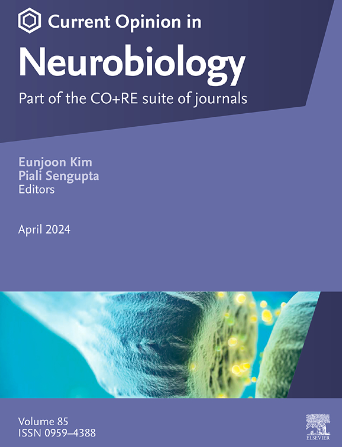Cracking the cadherin codes that wire the nervous system
IF 5.2
2区 医学
Q1 NEUROSCIENCES
引用次数: 0
Abstract
Synaptic partner recognition and precise connectivity are essential components of neural circuit formation and function. Cell adhesion molecules with selective binding properties provide instructive cues for synapse specificity. Yet, we know little about how they guide the stereotyped organization of neural circuits. Advances in transcriptomics, genetic manipulations, neural tracing and imaging in intact nervous systems enable new avenues to identify mechanisms by which adhesion molecules regulate synapse specificity. Here we discuss the Cadherin superfamily, which forms one of the most functionally versatile families of cell adhesion molecules. Focusing on the classical cadherins and clustered protocadherins, we discuss recent findings that demonstrate roles in regulating synaptic partnerships and signaling properties, and optimizing neurite wiring. We highlight studies that demonstrate instructive roles through genetic manipulations with assays of synaptic connectivity. Understanding how neurons leverage a Cadherin code for specifying neural connectivity provides insights into the broader principles of circuit assembly and function.
破解连接神经系统的钙粘蛋白密码
突触伴侣识别和精确连接是神经回路形成和功能的重要组成部分。具有选择性结合特性的细胞粘附分子为突触特异性提供了指导性线索。然而,我们对它们如何引导神经回路的刻板组织知之甚少。在完整神经系统中转录组学、遗传操作、神经追踪和成像的进展为鉴定粘附分子调节突触特异性的机制提供了新的途径。在这里,我们讨论钙粘蛋白超家族,它形成了功能最广泛的细胞粘附分子家族之一。关注经典钙粘蛋白和聚集型原钙粘蛋白,我们讨论了最近的发现,证明在调节突触伙伴关系和信号特性,优化神经突布线中的作用。我们强调的研究表明,通过遗传操作与突触连通性的测定具有指导作用。了解神经元如何利用钙粘蛋白代码来指定神经连接,可以深入了解电路组装和功能的更广泛原理。
本文章由计算机程序翻译,如有差异,请以英文原文为准。
求助全文
约1分钟内获得全文
求助全文
来源期刊

Current Opinion in Neurobiology
医学-神经科学
CiteScore
11.10
自引率
1.80%
发文量
130
审稿时长
4-8 weeks
期刊介绍:
Current Opinion in Neurobiology publishes short annotated reviews by leading experts on recent developments in the field of neurobiology. These experts write short reviews describing recent discoveries in this field (in the past 2-5 years), as well as highlighting select individual papers of particular significance.
The journal is thus an important resource allowing researchers and educators to quickly gain an overview and rich understanding of complex and current issues in the field of Neurobiology. The journal takes a unique and valuable approach in focusing each special issue around a topic of scientific and/or societal interest, and then bringing together leading international experts studying that topic, embracing diverse methodologies and perspectives.
Journal Content: The journal consists of 6 issues per year, covering 8 recurring topics every other year in the following categories:
-Neurobiology of Disease-
Neurobiology of Behavior-
Cellular Neuroscience-
Systems Neuroscience-
Developmental Neuroscience-
Neurobiology of Learning and Plasticity-
Molecular Neuroscience-
Computational Neuroscience
 求助内容:
求助内容: 应助结果提醒方式:
应助结果提醒方式:


